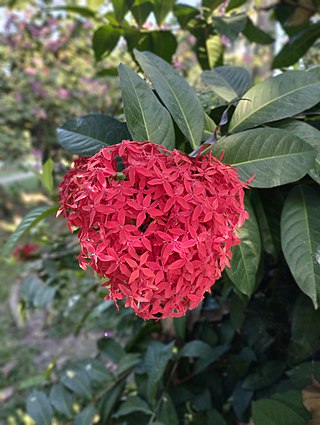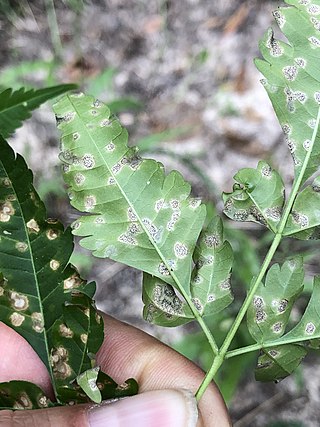
Spearmint, a species of mint (mentha) scientifically classified as Mentha spicata (,) also known as garden mint, common mint, lamb mint and mackerel mint, is native to Europe and southern temperate Asia, extending from Ireland in the west to southern China in the east. It is naturalized in many other temperate parts of the world, including northern and southern Africa, North America, and South America. It is used as a flavouring in food and herbal teas. The aromatic oil, called oil of spearmint, is also used as a flavoring and sometimes as a scent.
Blight refers to a specific symptom affecting plants in response to infection by a pathogenic organism.

Basil, also called great basil, is a culinary herb of the family Lamiaceae (mints). It is a tender plant, and is used in cuisines worldwide. In Western cuisine, the generic term "basil" refers to the variety also known as sweet basil or Genovese basil. Basil is native to tropical regions from Central Africa to Southeast Asia. In temperate climates basil is treated as an annual plant, however, basil can be grown as a short-lived perennial or biennial in warmer horticultural zones with tropical or Mediterranean climates.

Vitis vinifera, the common grape vine, is a species of flowering plant, native to the Mediterranean region, Central Europe, and southwestern Asia, from Morocco and Portugal north to southern Germany and east to northern Iran. There are currently between 5,000 and 10,000 varieties of Vitis vinifera grapes though only a few are of commercial significance for wine and table grape production.

Hevea brasiliensis, the Pará rubber tree, sharinga tree, seringueira, or most commonly, rubber tree or rubber plant, is a flowering plant belonging to the spurge family Euphorbiaceae originally native to the Amazon basin, but is now pantropical in distribution due to introductions. It is the most economically important member of the genus Hevea because the milky latex extracted from the tree is the primary source of natural rubber.

Melia azedarach, commonly known as the chinaberry tree, pride of India, bead-tree, Cape lilac, syringa berrytree, Persian lilac, Indian lilac, or white cedar, is a species of deciduous tree in the mahogany family, Meliaceae, that is native to Indomalaya and Australasia.

Backhousia citriodora is a flowering plant in the family Myrtaceae, genus Backhousia. It is endemic to subtropical rainforests of central and south-eastern Queensland, Australia, with a natural distribution from Mackay to Brisbane.

Ixora is a genus of flowering plants in the family Rubiaceae. It is the only genus in the tribe Ixoreae. It consists of tropical evergreen trees and shrubs and holds around 544 species. Though native to the tropical and subtropical areas throughout the world, its centre of diversity is in Tropical Asia. Ixora also grows commonly in subtropical climates in the United States, such as Florida where it is commonly known as West Indian jasmine.
Pseudocercospora fuligena is a fungal plant pathogen infecting tomatoes. It is the cause of the fungal disease black leaf mold. The fungus was first described in the Philippines in 1938 and has since been reported in numerous countries throughout the tropics and subtropics. It was reported in the United States in 1974, initially in Florida, and has since been reported in non-tropical regions including Ohio and North Carolina.
Pseudocercospora mali is a fungal plant pathogen infecting Apple trees. It was originally found on the living leaves of Pyrus malus in Louisiana, USA.
Pseudocercospora puderi is a fungal plant pathogen infecting roses, including Rosa gallica. It was originally found in Florida, USA.
Pseudocercospora purpurea is a fungal plant pathogen that causes a leaf spot on the avocado. Species Cercospora purpurea was originally found on the leaves of Persea species in Georgia, USA in 1878. before the species was transferred to the Pseudocercospora genus in 1976.

Pseudocercospora subsessilis is a fungal plant pathogen infecting chinaberry tree. It is widespread in tropical and subtropical areas on host species of the genera Azadirachta and Swietenia.

Plasmopara viticola, the causal agent of grapevine downy mildew, is a heterothallic oomycete that overwinters as oospores in leaf litter and soil. In the spring, oospores germinate to produce macrosporangia, which under wet condition release zoospores. Zoospores are splashed by rain into the canopy, where they swim to and infect through stomata. After 7–10 days, yellow lesions appear on foliage. During favorable weather the lesions sporulate and new secondary infections occur.
Isariopsis clavispora is a fungal plant pathogen that causes leaf spot on grape.
Mycosphaerella musicola is a fungal plant pathogen, which is the causal agent of Yellow Sigatoka leaf spot disease on banana plants.
Pseudocercospora kaki is a fungal plant pathogen, who causes leaf spot of persimmon. It was originally found on leaves of Diospyros kaki in Taiwan. Some examples of other host species are Diospyros hispida, Diospyros lotus, Diospyros texana, and Diospyros tupru.

Pseudocercospora is a genus of ascomycete fungi. An anamorphic version of the genus Mycosphaerella, Pseudocercospora species are plant pathogens, including the causal agent of the so-called South American leaf blight of the rubber tree. The widely distributed genus is concentrated predominantly in tropical regions. Pseudocercospora was circumscribed by Italian-Argentinian botanist Carlos Luigi Spegazzini in 1910.
Isariopsis is a genus of fungi in the family Mycosphaerellaceae. The plant disease called isariopsis leaf spot is actually caused by Pseudocercospora vitis, formerly known as I. vitis.










